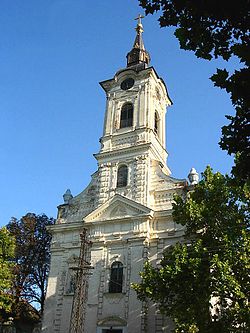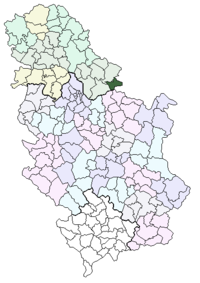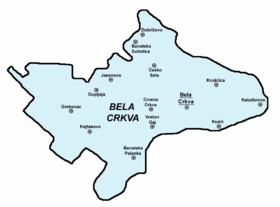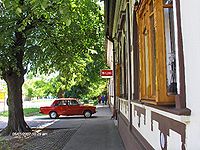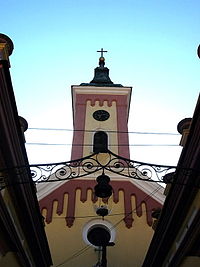- Bela Crkva (Vojvodina)
-
Bela Crkva
Бела Црква— Municipality and Town — The St. Ana Catholic Church 
Coat of armsLocation of the municipality of Bela Crkva within Serbia Coordinates: 44°54′N 21°25′E / 44.9°N 21.417°E Country Serbia District South Banat Settlements 14 Government – Mayor Boris Đurđev Area[1] – Municipality 353 km2 (136.3 sq mi) Population (2011 census)[2] – Town 10,675 – Municipality 20,367 Time zone CET (UTC+1) – Summer (DST) CEST (UTC+2) Postal code Area code +381 13 Car plates VŠ Website www.belacrkva.co.rs Bela Crkva (Бела Црква, pronounced [bɛ̂ːlaː tsr̩̂ːkv̞a]) is a town and municipality in the South Banat District of Vojvodina, Serbia. The town has a population of 10,638, while the Bela Crkva municipality has 20,275 inhabitants.
Bela Crkva lakes at the outskirts of the town are a popular summer tourist destination.
Contents
Name
The name of the town means "white church" in Serbian. In Romanian, the town is known as Biserica Albă, in German as Weißkirchen, in Hungarian as Fehértemplom, and in Turkish as Aktabya.
History
Neolithic findings of ceramics and burial with Greek-style pots dating to late 5th century BC.[3]
The town was founded in 1717 when this region was included into the Habsburg Monarchy. It was part of the Banatian Military Frontier of the Monarchy and, since 1774, was a seat of the Illyrian (Serbian) section of the Banatian Frontier except Ottoman occupation between 1787 and 1788. In 1848-1849, the town was part of autonomous Serbian Vojvodina, but in 1849 it was again placed under military administration. With the abolishment of the Military Frontier, the town was included into Temes county of the Kingdom of Hungary, one of two autonomous parts of Austria-Hungary. The town was also a seat of the district since 1867.
According to the 1910 census, the town itself was mainly populated by Germans, but its surrounding municipal area was mainly populated by Serbs. Census recorded 11,524 citizens in the town, of whom 6,062 spoke German language, 1,994 Serbian, 1,806 Romanian, and 1,213 Hungarian. The municipal area numbered 36,831 inhabitants, of whom 20,987 spoke Serbian, 8,234 Romanian, and 4,791 German. The total population of the town and its municipal area counted together was 48,355, of whom 22,981 spoke Serbian, 10,853 German, 10,040 Romanian, and 2,122 Hungarian.[4]
Since 1918, Bela Crkva was part of the Kingdom of Serbs, Croats and Slovenes and subsequent South Slavic states. In the 1920s it was a center of Russian emigration in Yugoslavia.
Inhabited places
Bela Crkva municipality includes the town of Bela Crkva and the following villages:
- Banatska Palanka
- Banatska Subotica
- Vračev Gaj
- Grebenac
- Dobričevo
- Dupljaja
- Jasenovo
- Kajtasovo
- Kaluđerovo
- Kruščica
- Kusić
- Crvena Crkva
- Češko Selo
Ethnic groups (2002 census)
The population of the Bela Crkva municipality:
Settlements with Serb ethnic majority are: Bela Crkva, Banatska Palanka, Banatska Subotica, Vračev Gaj, Dupljaja, Jasenovo, Kajtasovo, Kaluđerovo, Kruščica, Kusić, and Crvena Crkva. The settlement with Romanian ethnic majority is Grebenac. The settlement with Hungarian ethnic majority is Dobričevo. The settlement with Czech ethnic majority is Češko Selo.
See also
- List of places in Serbia
- List of cities, towns and villages in Vojvodina
References
- ^ "Municipalities of Serbia, 2006". Statistical Office of Serbia. http://webrzs.stat.gov.rs/axd/en/Zip/OG2006webE.zip. Retrieved 2010-11-28.
- ^ "2011 Census of Population, Households and Dwellings in the Republic of Serbia – FIRST RESULTS". Bulletin (Statistical Office of the Republic of Serbia) 540. 2011. ISSN 0354-3641. http://media.popis2011.stat.rs/2011/prvi_rezultati.pdf. Retrieved 2011-11-21.
- ^ The Illyrians-John Wilkes
- ^ http://www.talmamedia.com/php/district/district.php?county=Temes[dead link]
External links
Municipalities and cities of Serbia Central Serbia Belgrade (Barajevo • Čukarica • Grocka • Lazarevac • Mladenovac • Novi Beograd • Obrenovac • Palilula • Rakovica • Savski Venac • Sopot • Stari Grad • Surčin • Voždovac • Vračar • Zemun • Zvezdara) • Čačak • Jagodina • Kragujevac (Aerodrom • Pivara • Stanovo • Stari Grad • Stragari) • Kraljevo • Kruševac • Leskovac • Loznica • Niš (Crveni Krst • Medijana • Niška Banja • Palilula • Pantelej) • Novi Pazar • Požarevac • Smederevo • Šabac • Užice • Valjevo • Vranje • Zaječar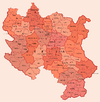 Aleksandrovac • Aleksinac • Aranđelovac • Arilje • Babušnica • Bajina Bašta • Batočina • Bela Palanka • Blace • Bogatić • Bojnik • Boljevac • Bor • Bosilegrad • Brus • Bujanovac • Crna Trava • Čajetina • Ćićevac • Ćuprija • Despotovac • Dimitrovgrad • Doljevac • Gadžin Han • Golubac • Gornji Milanovac • Ivanjica • Kladovo • Knić • Knjaževac • Koceljeva • Kosjerić • Krupanj • Kučevo • Kuršumlija • Lajkovac • Lapovo • Lebane • Lučani • Ljig • Ljubovija • Majdanpek • Mali Zvornik • Malo Crniće • Medveđa • Merošina • Mionica • Negotin • Nova Varoš • Osečina • Paraćin • Petrovac • Pirot • Požega • Preševo • Priboj • Prijepolje • Prokuplje • Rača • Raška • Ražanj • Rekovac • Sjenica • Smederevska Palanka • Sokobanja • Surdulica • Svilajnac • Svrljig • Topola • Trgovište • Trstenik • Tutin • Ub • Varvarin • Velika Plana • Veliko Gradište • Vladičin Han • Vladimirci • Vlasotince • Vrnjačka Banja • Žabari • Žagubica • Žitorađa
Aleksandrovac • Aleksinac • Aranđelovac • Arilje • Babušnica • Bajina Bašta • Batočina • Bela Palanka • Blace • Bogatić • Bojnik • Boljevac • Bor • Bosilegrad • Brus • Bujanovac • Crna Trava • Čajetina • Ćićevac • Ćuprija • Despotovac • Dimitrovgrad • Doljevac • Gadžin Han • Golubac • Gornji Milanovac • Ivanjica • Kladovo • Knić • Knjaževac • Koceljeva • Kosjerić • Krupanj • Kučevo • Kuršumlija • Lajkovac • Lapovo • Lebane • Lučani • Ljig • Ljubovija • Majdanpek • Mali Zvornik • Malo Crniće • Medveđa • Merošina • Mionica • Negotin • Nova Varoš • Osečina • Paraćin • Petrovac • Pirot • Požega • Preševo • Priboj • Prijepolje • Prokuplje • Rača • Raška • Ražanj • Rekovac • Sjenica • Smederevska Palanka • Sokobanja • Surdulica • Svilajnac • Svrljig • Topola • Trgovište • Trstenik • Tutin • Ub • Varvarin • Velika Plana • Veliko Gradište • Vladičin Han • Vladimirci • Vlasotince • Vrnjačka Banja • Žabari • Žagubica • ŽitorađaVojvodina  Ada • Alibunar • Apatin • Bač • Bačka Palanka • Bačka Topola • Bački Petrovac • Bečej • Bela Crkva • Beočin • Čoka • Inđija • Irig • Kanjiža • Kikinda • Kovačica • Kovin • Kula • Mali Iđoš • Nova Crnja • Novi Bečej • Novi Kneževac • Odžaci • Opovo • Pećinci • Plandište • Ruma • Sečanj • Senta • Šid • Srbobran • Sremski Karlovci • Stara Pazova • Temerin • Titel • Vrbas • Vršac • Žabalj • Žitište
Ada • Alibunar • Apatin • Bač • Bačka Palanka • Bačka Topola • Bački Petrovac • Bečej • Bela Crkva • Beočin • Čoka • Inđija • Irig • Kanjiža • Kikinda • Kovačica • Kovin • Kula • Mali Iđoš • Nova Crnja • Novi Bečej • Novi Kneževac • Odžaci • Opovo • Pećinci • Plandište • Ruma • Sečanj • Senta • Šid • Srbobran • Sremski Karlovci • Stara Pazova • Temerin • Titel • Vrbas • Vršac • Žabalj • ŽitišteKosovo Dečani • Đakovica • Dragaš • Glogovac • Gnjilane • Istok • Kačanik • Klina • Kosovo Polje • Kosovska Kamenica • Kosovska Mitrovica • Leposavić • Lipljan • Mališevo • Novo Brdo • Obilić • Orahovac • Peć • Podujevo • Priština • Prizren • Štimlje • Srbica • Štrpce • Suva Reka • Uroševac • Vitina • Vučitrn • Zubin Potok • Zvečan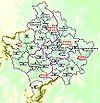 New Municipalities: Đeneral Janković • Gračanica • Junik • Klokot-Vrbovac • Mamuša • Parteš • RanilugCategories:
New Municipalities: Đeneral Janković • Gračanica • Junik • Klokot-Vrbovac • Mamuša • Parteš • RanilugCategories:- Places in Serbian Banat
- Populated places in South Banat District
- Municipalities of Vojvodina
Wikimedia Foundation. 2010.

